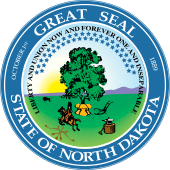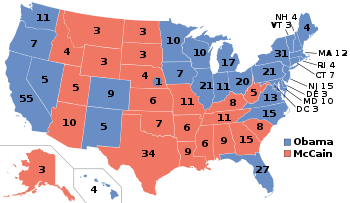United States presidential election in North Dakota, 2008
| | ||||||||||||||||||||||||||||||||
| ||||||||||||||||||||||||||||||||
| ||||||||||||||||||||||||||||||||
|
| ||||||||||||||||||||||||||||||||
| County Results
Obama—80-90%
Obama—70-80%
Obama—60-70%
Obama—50-60%
McCain—<50%
McCain—50-60%
McCain—60-70%
McCain—70-80% | ||||||||||||||||||||||||||||||||
| ||||||||||||||||||||||||||||||||
| Elections in North Dakota |
|---|
 |
The 2008 United States presidential election in North Dakota took place on November 4, 2008 throughout all 50 states and D.C., which was part of the 2008 United States presidential election. Voters chose 3 representatives, or electors to the Electoral College, who voted for President and Vice President.
North Dakota was won by Republican nominee John McCain by an 8.7% margin of victory. Prior to the election, most news organizations considered this a state McCain would win, or otherwise considered as a red state. The state has not been won by a Democratic presidential nominee since Lyndon B. Johnson's landslide election in 1964. Polls showed Republican John McCain and Democrat Barack Obama running unusually close in a state that gave George W. Bush a 27.4% margin of victory over John Kerry in 2004. In the end, McCain kept North Dakota in the GOP column but by a much smaller margin than Bush's landslide in 2004.
Caucuses
Campaign
Predictions
There were 17 news organizations who made state by state predictions of the election. Here are their last predictions before election day:
- D.C. Political Report: Republican[1]
- Cook Political Report: Toss Up[2]
- Takeaway: Leaning McCain[3]
- Election Projection: Leaning McCain[4]
- Electoral-vote.com: Leaning Republican[5]
- Washington Post: Leaning McCain[6]
- Politico: Solid McCain[7]
- Real Clear Politics: Toss Up[8]
- FiveThirtyEight.com: Solid McCain[6]
- CQ Politics: Toss Up[9]
- New York Times: Leaning Republican[10]
- CNN: Toss Up[11]
- NPR: Leaning McCain[6]
- MSNBC: Toss Up[6]
- Fox News: Republican[12]
- Associated Press: Republican[13]
- Rasmussen Reports: Safe Republican[14]
Polling
Pre-election polls showed a complete toss up. The final 3 polls averaged gave Obama leading 45% to 44%, leaving a lot of undecided voters.[15]
Fundraising
John McCain raised a total of $184,405 in the state. Barack Obama raised $191,551.[16]
Advertising and visits
Obama and his interest groups spent $448,361. McCain and his interest groups spent $71,972.[17] Obama visited the state once, in Fargo, North Dakota, while the Republican ticket didn't visit the state once.[18]
Analysis
North Dakota has been considered a reliably red state for the past 40 years, having voted for the Republican presidential nominee of every election since 1968. In 2008, however, polls taken before September surprisingly showed the two candidates running neck-to-neck. While the polls varied throughout the campaign, McCain's selection of the socially conservative Governor Sarah Palin of Alaska as his vice presidential running mate played well in North Dakota, a state that has the least nonreligious percentage of citizens per capita in the country. After Palin joined the ticked inlate August, McCain then took a double digit lead in the state until October, when polling once again showed a close race between the two candidates in the Peace Garden State.[19]
On Election Day 2008, however, McCain captured North Dakota by a fairly safe margin of approximately 8.60 points, despite the latest polling showing him just one point ahead of Obama.[20] Still, the statewide result was significantly closer than in 2004 when Bush carried the state by a much larger margin of more than 27 percent.[21] McCain did well throughout the western and central parts of the state, while Obama won several counties in the east including the most populous counties of Cass County (which contains the state's largest city of Fargo) and Grand Forks County (which includes the college town of Grand Forks.
At the same time, popular incumbent Republican Governor John Hoeven was reelected to a second term in a landslide three-to-one victory over Democrat Tim Mathern and Independent DuWayne Hendrickson. Hoeven received 74.44% of the vote while Mathern took in 23.53% and Hendrickson with the remaining 2.03%. Democrats, however, made gains at the state level, picking up three seats in the North Dakota House of Representatives and six seats in the North Dakota Senate.
Results
| United States presidential election in North Dakota, 2008[22] | ||||||
|---|---|---|---|---|---|---|
| Party | Candidate | Running mate | Votes | Percentage | Electoral votes | |
| Republican | John McCain | Sarah Palin | 168,887 | 53.15% | 3 | |
| Democratic | Barack Obama | Joe Biden | 141,403 | 44.50% | 0 | |
| Independent | Ralph Nader | Matt Gonzalez | 4,199 | 1.32% | 0 | |
| Write-ins | Write-ins | 1,123 | 0.35% | 0 | ||
| Libertarian | Bob Barr | Wayne Allyn Root | 1,067 | 0.34% | 0 | |
| Constitution | Chuck Baldwin | Darrell Castle | 1,059 | 0.33% | 0 | |
| Totals | 317,738 | 100.00% | 3 | |||
| Voter turnout (Voting age population) | 65.6% | |||||
Results breakdown
By congressional district
Due to the state's low population, only one congressional district is allocated. This district, called the At-Large district, because it covers the entire state, and thus is equivalent to the statewide election results.
| District | McCain | Obama | Representative |
|---|---|---|---|
| At-large | 53.1% | 44.5% | Earl Pomeroy |
Electors
Technically the voters of North Dakota cast their ballots for electors: representatives to the Electoral College. North Dakota is allocated 3 electors because it has 1 congressional districts and 2 senators. All candidates who appear on the ballot or qualify to receive write-in votes must submit a list of 3 electors, who pledge to vote for their candidate and his or her running mate. Whoever wins the majority of votes in the state is awarded all 3 electoral votes. Their chosen electors then vote for President and Vice President. Although electors are pledged to their candidate and running mate, they are not obligated to vote for them.[23] An elector who votes for someone other than his or her candidate is known as a faithless elector.
The electors of each state and the District of Columbia met on December 15, 2008 to cast their votes for President and Vice President. The Electoral College itself never meets as one body. Instead the electors from each state and the District of Columbia met in their respective capitols.
The following were the members of the Electoral College from the state. All 3 pledged to John McCain and Sarah Palin:[24][25][26]
- Theresa Tokach - replaced Richard Elkin
- Susan Wefald
- Cleo Thompson
References
- ↑ D.C.'s Political Report: The complete source for campaign summaries
- ↑ Presidential | The Cook Political Report Archived May 5, 2015, at the Wayback Machine.
- ↑ Vote 2008 - The Takeaway - Track the Electoral College vote predictions Archived April 22, 2009, at the Wayback Machine.
- ↑ Election Projection: 2008 Elections - Polls, Projections, Results
- ↑ Electoral-vote.com: President, Senate, House Updated Daily
- 1 2 3 4 Based on Takeaway
- ↑ POLITICO's 2008 Swing State Map - POLITICO.com
- ↑ RealClearPolitics - Electoral Map
- ↑ CQ Politics | CQ Presidential Election Maps, 2008 Archived October 29, 2008, at the Wayback Machine.
- ↑ "Electoral College Map". The New York Times. Retrieved 2010-05-26.
- ↑ "October – 2008 – CNN Political Ticker - CNN.com Blogs". CNN. Retrieved 2010-05-26.
- ↑ "Winning the Electoral College". Fox News. 2010-04-27.
- ↑ roadto270
- ↑ Election 2008: Electoral College Update - Rasmussen Reports™
- ↑ Election 2008 Polls - Dave Leip's Atlas of U.S. Presidential Elections
- ↑ Presidential Campaign Finance
- ↑ "Map: Campaign Ad Spending - Election Center 2008 from CNN.com". CNN. Retrieved 2010-05-26.
- ↑ "Map: Campaign Candidate Visits - Election Center 2008 from CNN.com". CNN. Retrieved 2010-05-26.
- ↑ "RealClearPolitics - Election 2008 - North Dakota". Retrieved 2008-11-19.
- ↑ "CNN Election Center 2008 - North Dakota". Retrieved 2008-11-19.
- ↑ "Electoral-vote.com". Retrieved 2008-11-19.
- ↑ "Atlas of U.S. Presidential Election". Retrieved January 13, 2013.
- ↑ "Electoral College". California Secretary of State. Archived from the original on October 30, 2008. Retrieved 2008-11-01.
- ↑ http://www.nd.gov/sos/forms/pdf/presidential-candidates.pdf
- ↑ U. S. Electoral College 2008 Certificate
- ↑ KFYR-TV North Dakota's NBC News Leader Archived January 13, 2009, at the Wayback Machine.



